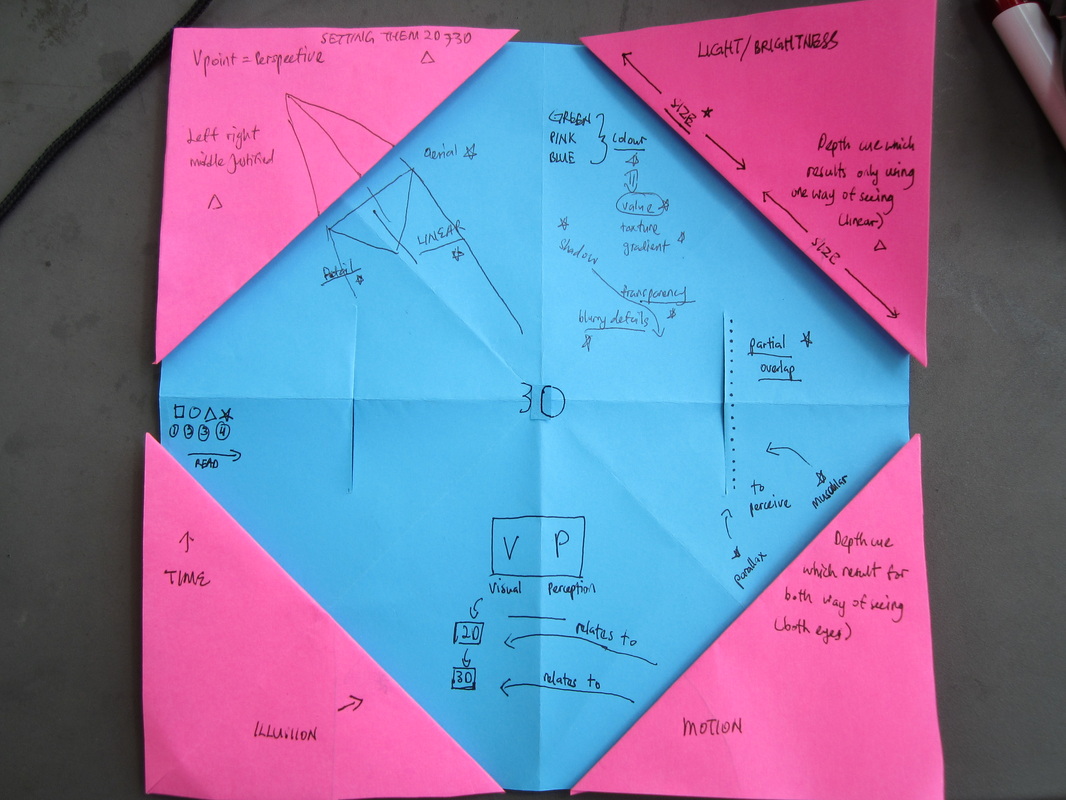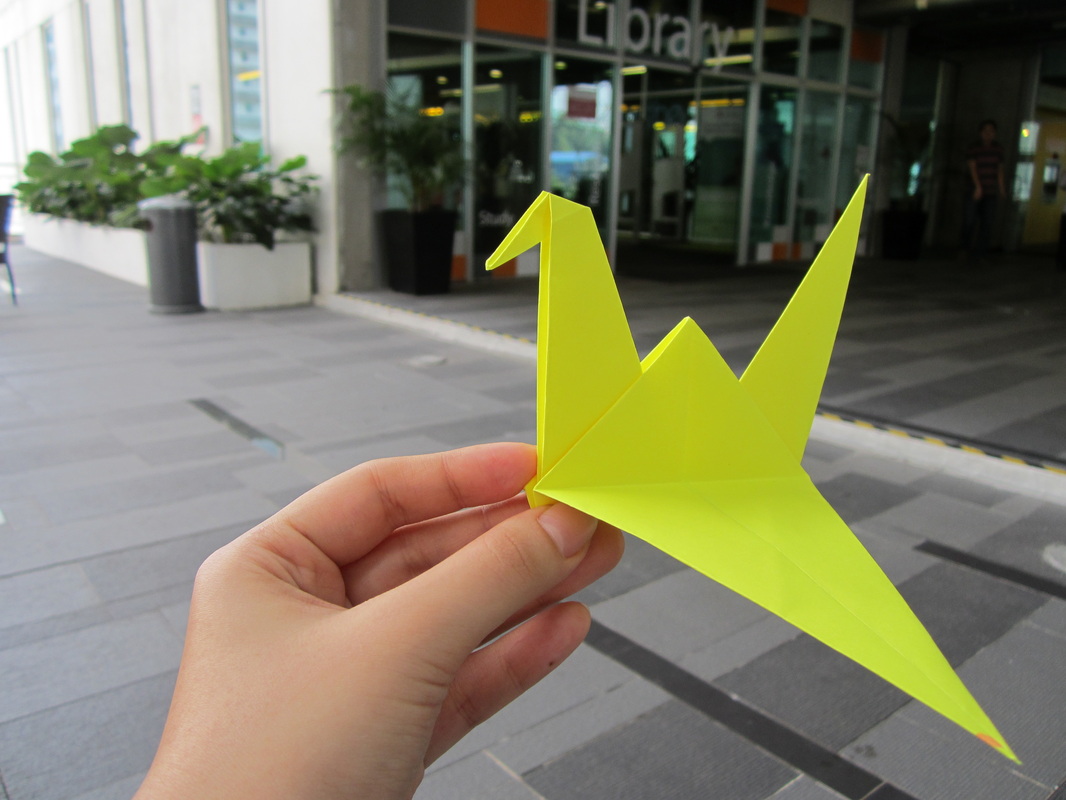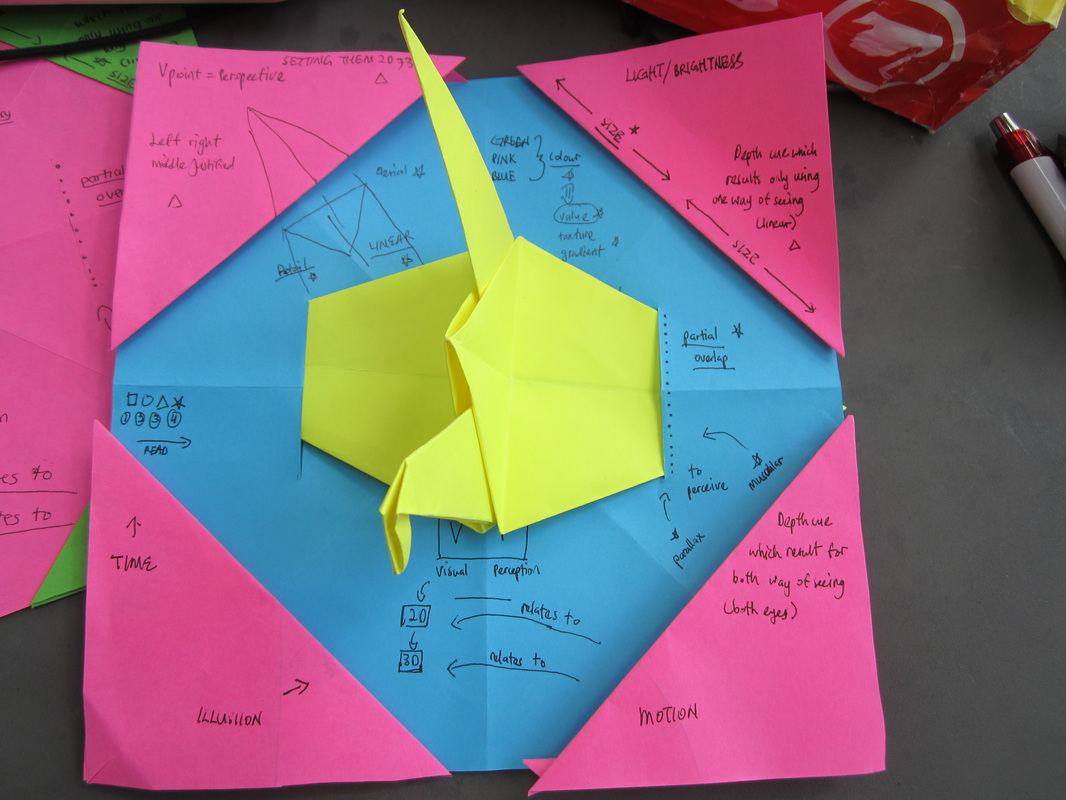We were told to bring 3 pieces of coloured paper and a pair of scissors. I thought we were going to do some make some origami but I was wrong. Turned out, Miss Ivy wanted to teach us about visual perception using those materials. But first she asked to fold an art piece. Here's the outcome.
Visual perception is the ability to interpret the surrounding environment by processing information that is contained in visible light.
We have two types of objects in this concept; 3D and 2D. A three-dimensional figure, sometimes called a solid figure, is a set of plane regions and surface regions, all lying in three-dimensional space while a two-dimensional figure, also called a plane or planar figure, is a set of line segments or sides and curve segments or arcs, all lying in a single plane. For example, this crane is 3D. It has volume and you can turn it to view it from another side. As you can see on the picture above, the crane is labelled with distance, depth and size/space.
There are a few principles in visual perception:
1. Orientation
An object's orientation may be left, right, middle or justified.
2. Position
Linear perspective is one of the most commonly used in two-dimensional artwork to give the perception of three dimensions. According to linear perspective, far objects are systematically smaller in size than nearer objects. Thus, parallel tracks appear to converge at a point called the vanish point.
Interposition happens when objects are overlapping. The object that is partially covered by another one appears to be in the back.
3. Light/brightness
According to this principle, 'color' (yellow, pink, blue) equals to 'value' which comprises of 'texture gradient'. Texture gradient is the distortion in size which closer objects have compared to objects farther away. The texture gradient is based upon transparency and blurriness of details.
4. Monocular Cues
These cues allow the judgement of distance and depth using one eye (linear). Cues of this type occur in each eye and can operate independently of the other eye.
5. Binocular Cues
These are depth cues which result for both way of seeing (both eyes). Binocular cues allows us to perceive a 3-D object using parallax disparity of our eyes and convergence of extraocular muscles which help determine depth/distance perception.
6. Motion
As in other aspects of vision, the observer's visual input is generally insufficient to determine the true nature of stimulus sources, in this case their velocity in the real world. In monocular vision for example, the visual input will be a 2-D projection of a 3-D space. The motion cues present in the 2-D projection will by default be insufficient to reconstruct the motion present in the 3-D space. Put differently, many 3-D scenes will be compatible with a single 2-D projection. The problem of motion estimation generalizes to binocular vision when we consider occlusion or motion perception at relatively large distances, where binocular disparity is a poor cue to depth.
7. Illusion
Similar to the concept of motion, we depend on motion of 3-D in 2-D spaces to create illusion.
8. Time
We read in chronological order, hence we perceive objects in the same order as well.
We have two types of objects in this concept; 3D and 2D. A three-dimensional figure, sometimes called a solid figure, is a set of plane regions and surface regions, all lying in three-dimensional space while a two-dimensional figure, also called a plane or planar figure, is a set of line segments or sides and curve segments or arcs, all lying in a single plane. For example, this crane is 3D. It has volume and you can turn it to view it from another side. As you can see on the picture above, the crane is labelled with distance, depth and size/space.
There are a few principles in visual perception:
1. Orientation
An object's orientation may be left, right, middle or justified.
2. Position
Linear perspective is one of the most commonly used in two-dimensional artwork to give the perception of three dimensions. According to linear perspective, far objects are systematically smaller in size than nearer objects. Thus, parallel tracks appear to converge at a point called the vanish point.
Interposition happens when objects are overlapping. The object that is partially covered by another one appears to be in the back.
3. Light/brightness
According to this principle, 'color' (yellow, pink, blue) equals to 'value' which comprises of 'texture gradient'. Texture gradient is the distortion in size which closer objects have compared to objects farther away. The texture gradient is based upon transparency and blurriness of details.
4. Monocular Cues
These cues allow the judgement of distance and depth using one eye (linear). Cues of this type occur in each eye and can operate independently of the other eye.
5. Binocular Cues
These are depth cues which result for both way of seeing (both eyes). Binocular cues allows us to perceive a 3-D object using parallax disparity of our eyes and convergence of extraocular muscles which help determine depth/distance perception.
6. Motion
As in other aspects of vision, the observer's visual input is generally insufficient to determine the true nature of stimulus sources, in this case their velocity in the real world. In monocular vision for example, the visual input will be a 2-D projection of a 3-D space. The motion cues present in the 2-D projection will by default be insufficient to reconstruct the motion present in the 3-D space. Put differently, many 3-D scenes will be compatible with a single 2-D projection. The problem of motion estimation generalizes to binocular vision when we consider occlusion or motion perception at relatively large distances, where binocular disparity is a poor cue to depth.
7. Illusion
Similar to the concept of motion, we depend on motion of 3-D in 2-D spaces to create illusion.
8. Time
We read in chronological order, hence we perceive objects in the same order as well.



 RSS Feed
RSS Feed